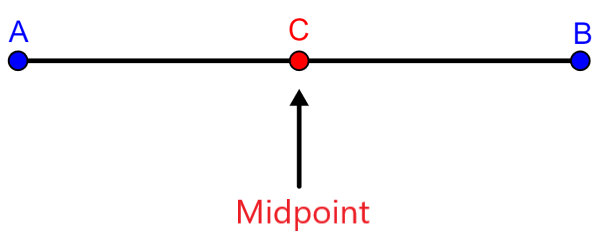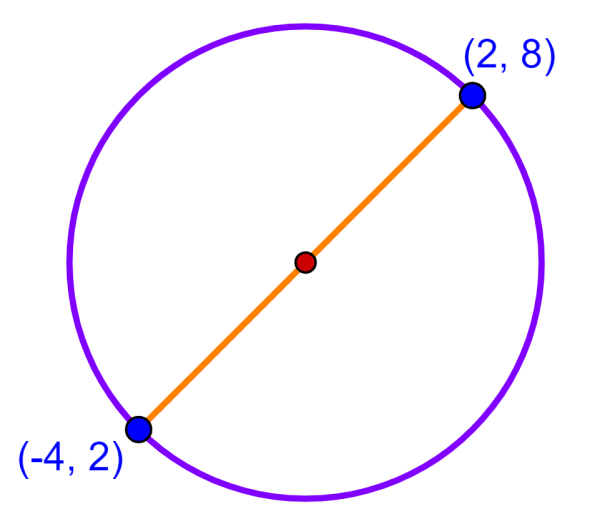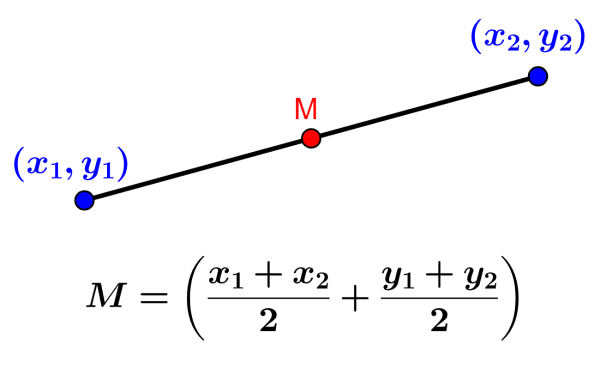The midpoint of a segment represents the point that is located exactly in the middle of the two endpoints of the segment. The midpoint can be found by dividing the sum of the x-coordinates by 2 and dividing the sum of the y-coordinates by 2.
Here, we will learn about the formula that we can use to calculate the midpoint of a segment. Also, we will use that formula to solve some practice examples.
What is the midpoint?
The midpoint is a point that is located exactly in the middle of a line segment that joins two points. For example, if we have two points and we join them with a line segment, the midpoint will be located in the middle of that segment and will be equidistant from both points.
In the following diagram, we have points A and B, which are joined by a segment. Point C is the midpoint since it is exactly in the middle of the segment. To calculate the location of the midpoint, we simply have to measure the length of the segment and divide it by 2.

A midpoint can be calculated only when we have a segment that joins two points since it has a defined location. The midpoint cannot be calculated for a line or a ray since a line has two ends that extend indefinitely and a ray has one end that extends indefinitely.
Formula for the midpoint of a line segment
The formula for the midpoint of a line segment is derived using the coordinates of the endpoints of the segment. The midpoint is equal to half the sum of the x-coordinates of the points and half the y-coordinates of the points.
Therefore, if we have points A and B with the coordinates $latex A = (x_{1}, y_{1})$ and $latex B = (x_{2}, y_{2})$, the formula for the midpoint is:
Formula for the midpoint
$$M=\left( \frac{x_{1}+x_{2}}{2}+\frac{y_{1}+y_{2}}{2}\right)$$
The midpoint will be expressed as the coordinates $latex M = (x_{3}, y_{3})$.
Midpoint of a line segment – Examples with answers
EXAMPLE 1
Find the midpoint of a line segment that joins the points (2, 5) and (6, 9).
Solution
We have the following coordinates:
- $latex (x_{1}, y_{1})=(2, 5)$
- $latex (x_{2}, y_{2})=(6, 9)$
Now, we use the midpoint formula with the given coordinates:
$$M=\left(\frac{x_{1}+x{2}}{2},\frac{y_{1}+y{2}}{2}\right)$$
$$=\left(\frac{2+6}{2},\frac{5+9}{2}\right)$$
$$=\left(\frac{8}{2},\frac{14}{2}\right)$$
$latex =(4,7)$
The midpoint is $latex M=(4, 7)$.
EXAMPLE 2
What is the midpoint between the points (2, 6) and (8, 12)?
Solution
We have the following coordinates:
- $latex (x_{1}, y_{1})=(2, 6)$
- $latex (x_{2}, y_{2})=(8, 12)$
We use the coordinates given in the midpoint formula:
$$M=\left(\frac{x_{1}+x{2}}{2},\frac{y_{1}+y{2}}{2}\right)$$
$$=\left(\frac{2+8}{2},\frac{6+12}{2}\right)$$
$$=\left(\frac{10}{2},\frac{18}{2}\right)$$
$latex =(5, 9)$
The coordinates of the midpoint are $latex M = (5, 9)$.
EXAMPLE 3
What is the midpoint of a line segment joining the points (4, 7) and (9, 10)?
Solution
We can write as follows:
- $latex (x_{1}, y_{1})=(4, 7)$
- $latex (x_{2}, y_{2})=(9, 10)$
Applying the midpoint formula with the given coordinates, we have:
$$M=\left(\frac{x_{1}+x{2}}{2},\frac{y_{1}+y{2}}{2}\right)$$
$$=\left(\frac{4+9}{2},\frac{7+10}{2}\right)$$
$$=\left(\frac{13}{2},\frac{17}{2}\right)$$
The midpoint is $latex M=\left(\frac{13}{2},\frac{17}{2}\right)$.
EXAMPLE 4
Determine the midpoint between the points (5, 7) and (9, 13).
Solution
We have the following points:
- $latex (x_{1}, y_{1})=(5, 7)$
- $latex (x_{2}, y_{2})=(9, 13)$
We apply the midpoint formula with these points:
$$M=\left(\frac{x_{1}+x{2}}{2},\frac{y_{1}+y{2}}{2}\right)$$
$$=\left(\frac{5+9}{2},\frac{7+13}{2}\right)$$
$$=\left(\frac{14}{2},\frac{20}{2}\right)$$
$latex =(7,10)$
The coordinates of the midpoint are $latex M=(7, 10)$.
EXAMPLE 5
If we have the points (-4, -2) and (6, 5) joined by a line segment, what is their midpoint?
Solution
We have the following values:
- $latex (x_{1}, y_{1})=(-4, -2)$
- $latex (x_{2}, y_{2})=(6, 5)$
In this case, we have negative coordinates, however, we simply apply the midpoint formula as in the previous exercises:
$$M=\left(\frac{x_{1}+x{2}}{2},\frac{y_{1}+y{2}}{2}\right)$$
$$ =\left(\frac{-4+6}{2},\frac{-2+5}{2}\right)$$
$$=\left(\frac{2}{2},\frac{3}{2}\right)$$
$$=\left(1,\frac{3}{2}\right)$$
The midpoint has the coordinates $latex M=\left(1,\frac{3}{2}\right)$.
EXAMPLE 6
Find the midpoint if we have the points (-5, -6) and (6, -2).
Solution
We write the coordinates as follows:
- $latex (x_{1}, y_{1})=(-5, -6)$
- $latex (x_{2}, y_{2})=(6, -2)$
In this case, we have negative coordinates, but we simply use the midpoint formula as in the previous exercises:
$$M=\left(\frac{x_{1}+x{2}}{2},\frac{y_{1}+y{2}}{2}\right)$$
$$=\left(\frac{-5+6}{2},\frac{-6-2}{2}\right)$$
$$=\left(\frac{1}{2},\frac{-8}{2}\right)$$
$$=\left(\frac{1}{2}, -4\right)$$
The midpoint has the coordinates $latex M=\left(\frac{1}{2}, -4\right)$.
EXAMPLE 7
The diameter of a circle has the endpoints (-4, 2) and (2, 8). What are the coordinates of the center of the circle?

Solution
The center of the circle divides the diameter into two equal parts. That means that to find the center, we have to find the coordinates of the midpoint of the diameter. Therefore, we start with the coordinates:
- $latex (x_{1}, y_{1})=(-4,2)$
- $latex (x_{2}, y_{2})=(2,8)$
Now, we apply the midpoint formula with these coordinates:
$$M=\left(\frac{x_{1}+x{2}}{2},\frac{y_{1}+y{2}}{2}\right)$$
$$=\left(\frac{-4+2}{2},\frac{2+8}{2}\right)$$
$$=\left(\frac{-2}{2},\frac{10}{2}\right)$$
$latex =(-1,5)$
The coordinates of the center of the circle are $latex (-1, 5)$.
EXAMPLE 8
The endpoints of a segment are (p, 4) and (8, 10). Find the value of p if the midpoint is (3, 7).
Solution
We write the given coordinates:
- $latex (x_{1}, y_{1})=(p, 4)$
- $latex (x_{2}, y_{2})=(8, 10)$
Now, we can apply the midpoint formula with the known values:
$$M=\left(\frac{x_{1}+x{2}}{2},\frac{y_{1}+y{2}}{2}\right)$$
$$=\left(\frac{p+8}{2},\frac{4+10}{2}\right)$$
In this case, we have to find the value of p which is part of the x coordinates of the midpoint. Therefore, we just consider the x component, we form an equation and solve for p. We know that the x coordinate of the midpoint is 3, so we have
$$3=\left(\frac{p+8}{2}\right)$$
$latex 6=p+8$
$latex p=-2$
The value of p is -2.
EXAMPLE 9
If the midpoint of a segment is (-2, 1) and its endpoints are (-6, q) and (2, 4), what is the value of q?
Solution
We have the following coordinates:
- $latex (x_{1}, y_{1})=(-6, x)$
- $latex (x_{2}, y_{2})=(2, -4)$
When we apply the midpoint formula, we have:
$$M=\left(\frac{x_{1}+x{2}}{2},\frac{y_{1}+y{2}}{2}\right)$$
$$=\left(\frac{-6+2}{2},\frac{q+4}{2}\right)$$
To find the value of q, we form an equation with the y-coordinate of the midpoint:
$$\left(\frac{q+4}{2}\right)=1$$
$latex q+4=2$
$latex q=-2$
The value of q is -2.
EXAMPLE 10
The midpoint of a segment has coordinates (-3, -4). If the endpoints of the segment are (3, -1) and (m, -7), find the value of m.
Solution
We start with the following coordinates:
- $latex (x_{1}, y_{1})=(3, -1)$
- $latex (x_{2}, y_{2})=(m, -7)$
Applying the midpoint formula, we have:
$$M=\left(\frac{x_{1}+x{2}}{2},\frac{y_{1}+y{2}}{2}\right)$$
$$=\left(\frac{3+m}{2},\frac{-1-7}{2}\right)$$
Similar to the previous examples, we only have to consider the x-coordinates of the midpoint and form an equation:
$$\left(\frac{3+m}{2}\right)=-3$$
$latex 3+m=-6$
$latex m=-9$
The value of m is -9.
Midpoint of a line segment – Practice problems


A segment is defined by the points (p, 3) and (5, 13). If the midpoint is (1, 8), what is the value of p?
Write the answer in the input box.
See also
Interested in learning more about distance, midpoint, and slope on the plane? Take a look at these pages:




